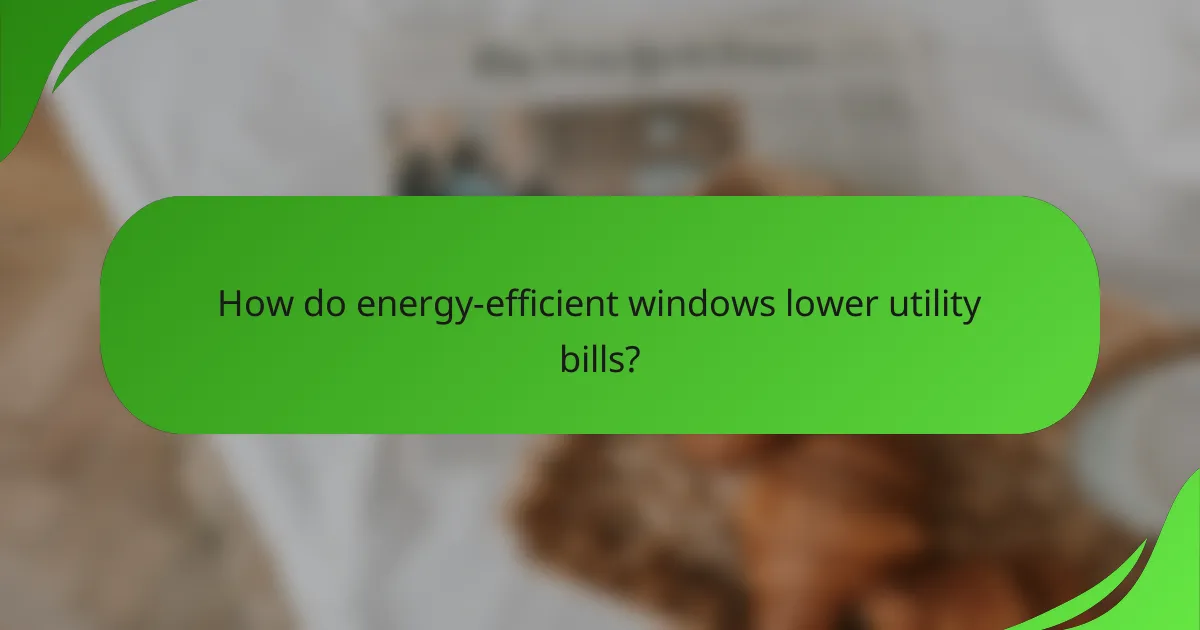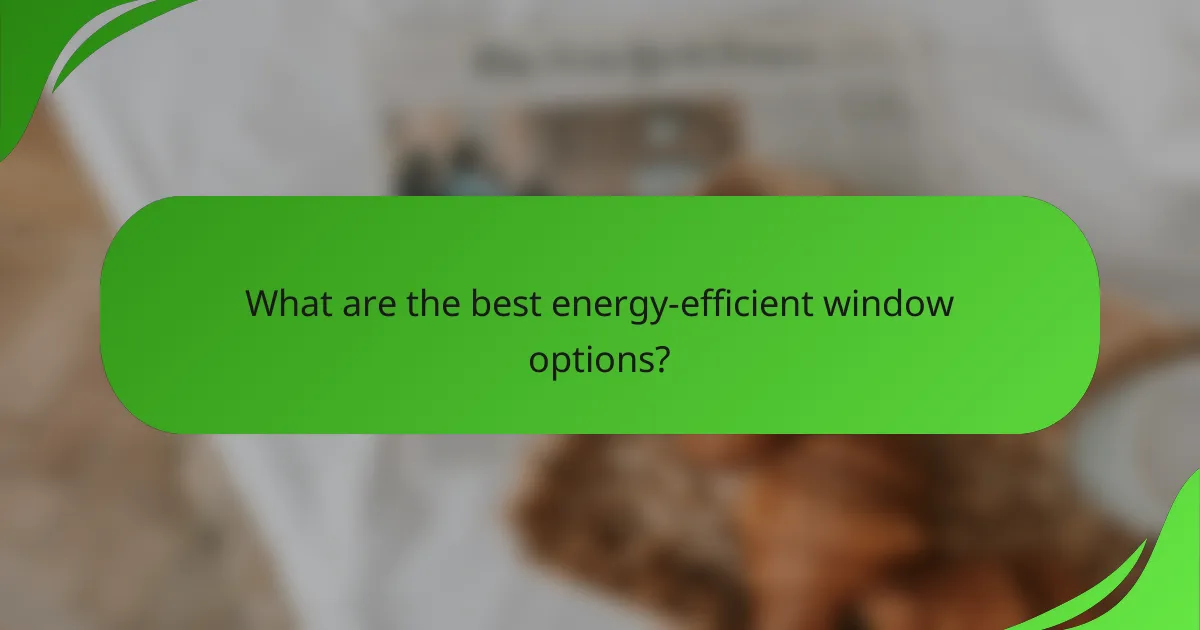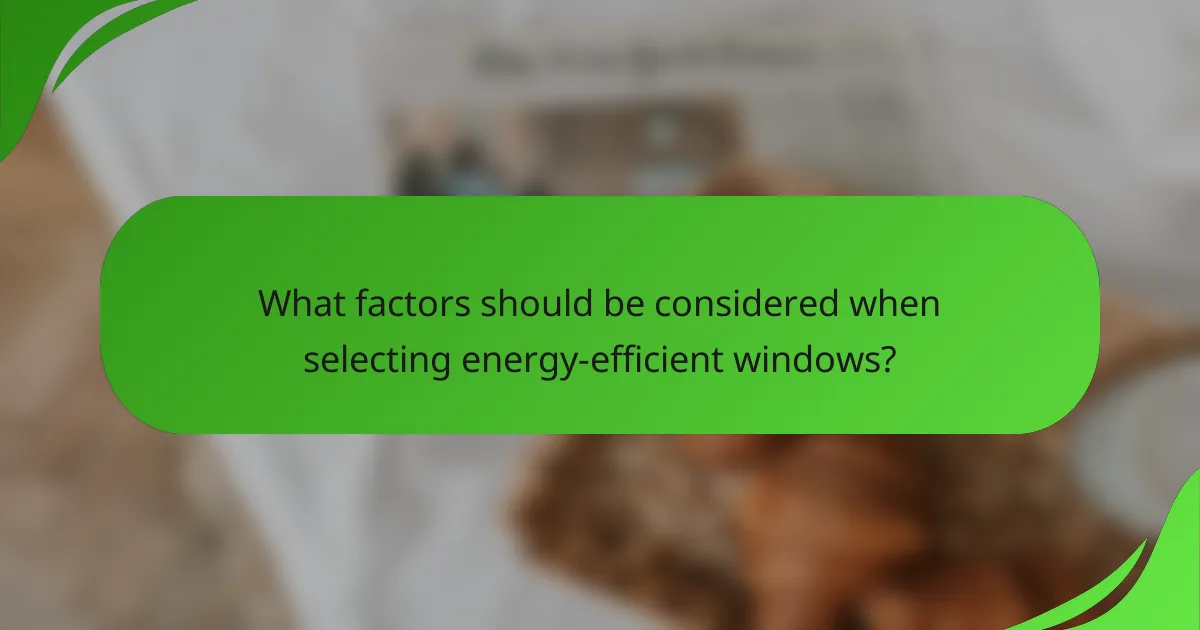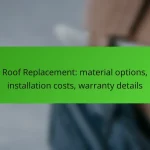Energy-efficient windows are a smart investment that can significantly lower utility bills by reducing heat transfer, thereby decreasing the workload on heating and cooling systems. They not only enhance indoor comfort by maintaining stable temperatures and minimizing drafts, but also provide noise reduction benefits, creating a more serene living environment.

How do energy-efficient windows lower utility bills?
Energy-efficient windows lower utility bills by minimizing heat transfer, which reduces the need for heating and cooling systems to work harder. This efficiency leads to lower energy consumption and, consequently, reduced utility costs.
Reduced heat loss
Energy-efficient windows are designed to minimize heat loss during colder months. They typically feature multiple panes of glass, often filled with inert gases like argon or krypton, which act as insulation. This design can reduce heat loss by up to 50% compared to standard single-pane windows.
When selecting windows, look for those with a low U-factor, which measures the rate of heat transfer. A lower U-factor indicates better insulation, helping to keep your home warm without excessive energy use.
Improved insulation
Improved insulation in energy-efficient windows is achieved through advanced frame materials and glazing technologies. Frames made from materials like vinyl or fiberglass provide better thermal performance than traditional aluminum frames. Additionally, low-emissivity (Low-E) coatings on the glass reflect heat back into the room, enhancing insulation.
Choosing windows with a high R-value, which measures thermal resistance, can further enhance your home’s energy efficiency. Look for products that meet or exceed local energy efficiency standards to ensure optimal performance.
Lower HVAC demand
By reducing heat loss and improving insulation, energy-efficient windows lower the demand on heating, ventilation, and air conditioning (HVAC) systems. This decreased demand not only leads to lower energy bills but also extends the lifespan of HVAC units due to less frequent cycling.
To maximize these benefits, consider installing energy-efficient windows in conjunction with other energy-saving measures, such as proper insulation in walls and attics. This holistic approach can significantly enhance overall energy efficiency and comfort in your home.

What are the best energy-efficient window options?
The best energy-efficient window options include double-pane, triple-pane, and low-E glass windows. Each type offers distinct advantages in terms of insulation, comfort, and noise reduction, making them suitable for various climates and budgets.
Double-pane windows
Double-pane windows consist of two layers of glass with a space in between, typically filled with argon gas for better insulation. This design significantly reduces heat transfer, helping to maintain indoor temperatures and lower energy bills.
When considering double-pane windows, look for those with a low U-factor, which indicates better insulating properties. They are generally a cost-effective option, providing a good balance between performance and price.
Triple-pane windows
Triple-pane windows feature three layers of glass, offering superior insulation compared to double-pane options. The additional layer further reduces heat loss and can enhance soundproofing, making them ideal for noisy environments.
While triple-pane windows tend to be more expensive upfront, they can lead to significant long-term savings on energy costs. They are particularly beneficial in extreme climates where maintaining consistent indoor temperatures is crucial.
Low-E glass windows
Low-E (low emissivity) glass windows are coated with a thin layer that reflects heat while allowing natural light to enter. This technology helps keep homes cooler in summer and warmer in winter, improving overall energy efficiency.
When selecting low-E glass windows, consider the climate in your area. In warmer regions, a low-E coating that reflects solar heat is advantageous, while colder climates benefit from coatings that retain heat. These windows can be combined with double or triple-pane designs for enhanced performance.

How do energy-efficient windows improve comfort?
Energy-efficient windows enhance comfort by maintaining stable indoor temperatures, reducing drafts, and maximizing natural light. These windows are designed to minimize heat transfer, which leads to a more consistent and pleasant living environment.
Consistent indoor temperatures
Energy-efficient windows help regulate indoor temperatures by reducing heat loss in winter and minimizing heat gain in summer. This insulation effect means that homes stay warmer during colder months and cooler during warmer months, leading to less reliance on heating and cooling systems.
When selecting windows, look for those with a low U-factor, which indicates better insulation properties. Double or triple glazing is often recommended for optimal performance, as these layers trap air or gas between panes, enhancing thermal resistance.
Reduced drafts
Drafts can significantly impact comfort levels, making spaces feel colder or warmer than desired. Energy-efficient windows are designed to seal tightly, preventing air leakage that causes drafts. This feature not only improves comfort but also enhances energy efficiency.
To ensure your windows are effective, check for proper installation and consider using weather stripping or caulking around frames. Regular maintenance can also help maintain the integrity of seals over time.
Enhanced natural light
Energy-efficient windows often feature advanced glazing technologies that allow more natural light into your home while blocking harmful UV rays. This balance helps create a brighter living space without the negative effects of excessive heat or glare.
When choosing windows, consider options with a high Visible Transmittance (VT) rating, which indicates how much light passes through. This can enhance your home’s ambiance and reduce the need for artificial lighting during the day, further contributing to energy savings.

What noise reduction benefits do energy-efficient windows provide?
Energy-efficient windows significantly reduce noise pollution, enhancing comfort in homes and offices. By utilizing advanced materials and designs, these windows can block a substantial amount of external sound, creating a quieter indoor environment.
Soundproofing features
Energy-efficient windows often incorporate soundproofing features such as multiple panes of glass, insulated frames, and airtight seals. These elements work together to minimize sound transmission from outside to inside. For example, double or triple glazing can reduce noise levels by 20-30 decibels compared to single-pane windows.
When selecting windows, look for products with a high Sound Transmission Class (STC) rating, which indicates their effectiveness at blocking sound. Generally, an STC rating of 30 or higher is recommended for noticeable noise reduction.
Acoustic glass options
Acoustic glass is a specialized type of glass designed specifically for noise reduction. It features a thicker outer pane and a laminated inner layer that absorbs sound waves, making it particularly effective in urban areas or near busy roads. This glass can reduce noise by up to 50% compared to standard glass.
Consider acoustic glass if you live in a high-noise environment. While it may come at a higher cost, the benefits of reduced noise and improved comfort can outweigh the initial investment. Always consult with a professional to determine the best options for your specific needs and local conditions.

What factors should be considered when selecting energy-efficient windows?
When selecting energy-efficient windows, consider factors such as climate zone, window frame materials, and installation quality. Each of these elements plays a crucial role in maximizing energy savings, enhancing comfort, and reducing noise levels in your home.
Climate zone
Your climate zone significantly influences the type of energy-efficient windows you should choose. For instance, in colder regions, double or triple-glazed windows with low U-values are ideal for minimizing heat loss. Conversely, warmer climates benefit from windows that reflect solar heat, often featuring low solar heat gain coefficients (SHGC).
To determine your climate zone, consult local building codes or resources like the U.S. Department of Energy’s climate zone map. This will help you select windows that are tailored to your specific environmental conditions.
Window frame materials
The material of your window frames affects both energy efficiency and durability. Common options include vinyl, wood, aluminum, and fiberglass. Vinyl frames are typically low-maintenance and offer good insulation, while wood frames provide excellent thermal performance but require more upkeep.
Consider the long-term costs and benefits of each material. For example, while aluminum frames are strong and lightweight, they may require thermal breaks to improve insulation. Weigh these factors against your budget and aesthetic preferences.
Installation quality
Proper installation is critical for maximizing the energy efficiency of your windows. Poorly installed windows can lead to air leaks, which undermine their insulating properties. Ensure that your installation team is experienced and follows best practices, such as using appropriate sealants and flashing.
To avoid common pitfalls, ask for references and check reviews of your installer. A well-installed window can significantly enhance your home’s comfort and reduce utility bills, making it a worthwhile investment.

How do energy-efficient windows compare in pricing?
Energy-efficient windows typically have a higher upfront cost compared to standard windows, but they offer significant benefits that can justify the investment. The price difference can vary based on materials, features, and installation, but understanding the overall financial impact is crucial for homeowners.
Initial investment
The initial investment for energy-efficient windows can range from a few hundred to over a thousand dollars per window, depending on the type and brand. Options like double or triple glazing, low-E coatings, and gas fills can increase costs but enhance performance. Homeowners should consider both the quality of materials and the reputation of the manufacturer when selecting windows.
Installation costs can also vary significantly, often adding 10-30% to the total price. Hiring a qualified contractor is essential to ensure proper installation, which can affect the window’s efficiency and lifespan.
Long-term savings
Long-term savings from energy-efficient windows can be substantial, often reducing energy bills by 10-25%. These windows help maintain indoor temperatures, leading to less reliance on heating and cooling systems. Over time, the savings can offset the initial investment, making them a financially sound choice.
In regions with extreme weather, the savings can be even more pronounced. Homeowners should calculate their potential energy savings based on local utility rates and climate conditions to better understand the financial benefits.
Tax credits and rebates
Many governments offer tax credits and rebates for homeowners who install energy-efficient windows, which can significantly reduce the overall cost. In the United States, for example, the federal government may provide tax credits for qualifying windows that meet specific energy efficiency standards.
Homeowners should check with local utility companies and state programs for additional incentives, as these can vary widely. Keeping documentation of the purchase and installation can help ensure eligibility for these financial benefits.








